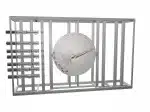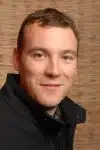A shoulder-joint implant, with the ball and socket on the opposite bones from nature, can significantly improve the quality of life of patients with severe arthritis and tendon tears, says medical engineer David Ackland from the University of Melbourne.
In a search for a more effective replacement joint, David and his colleagues looked at the counterintuitive ‘reverse’ implant, which was designed and manufactured in the US by Zimmer, Inc. Their tests on the Zimmer implant showed that it stabilises the joint and increases the range of movement of arthritic shoulders. His work is being presented for the first time in public through Fresh Science, a communication boot camp for early career scientists held at the Melbourne Museum last week. David was one of 16 winners from across Australia.
Arthritis and problems to do with muscles, joints and bones disable more people more severely than any other medical conditions, David says. “Many arthritis sufferers have to cope with chronic and debilitating pain and loss of joint function, for which there are very few effective treatments.”

David Ackland used a sophisticated rig to test the joint in a multitude of positions (image: David Ackland)
“These new implants increase the leverage of the muscles surrounding the shoulder, and thereby reduce the force required to move the arm. This lowers muscle stresses during everyday tasks such as lifting and pushing, and it also substantially increases the range of motion of the joint.”
After designing and building his own shoulder-testing equipment, David worked with orthopaedic surgeons from Melbourne’s Epworth Hospital who implanted eight of these artificial joints into the shoulders of donated human cadavers. During testing, the shoulders were manipulated to simulate common arm motions, while the properties of the muscles and joints were measured.
-
- Data from this study is not only helping surgeons to understand the clinical and biomechanical benefits of the shoulder reconstruction, but also has suggested ways in which surgeons can minimise postoperative failure and specific strategies for rehabilitation. David hopes that his research will lead to further improvements in the design of a range of joint replacements for the human body.
David Ackland is one of 16 early-career scientists releasing their research to the public for the first time thanks to Fresh Science, a national program sponsored by the Australian Government. His challenges have included talking to urban and rural school children and presenting his discoveries in verse at a Melbourne pub.
For further information, contact David Ackland at dackland@unimelb.edu.au








 Fresh Science is on hold for 2022. We will be back in 2023.
Fresh Science is on hold for 2022. We will be back in 2023.